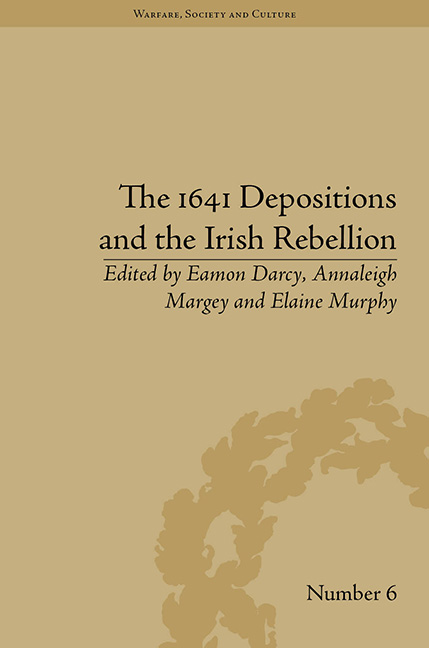Book contents
- Frontmatter
- CONTENTS
- Dedication
- Acknowledgements
- List of Contributors
- List of Figures and Tables
- List of Abbreviations
- Preface
- Introduction
- Part I The Outbreak of the Rebellion
- 1 Owen Connolly, Hugh Og MacMachon and the 1641 Rebellion in Clogher
- 2 What do the Depositions say about the Outbreak of the 1641 Rising?
- 3 Mapping the Outbreak of the Rebellion: Robberies in County Cavan (October 1641)
- 4 Mount Taragh's Triumph: Commitment and Organization in the Early Stages of the 1641 Rebellion in Meath
- Part II Social Aspects of the Rebellion
- Part III Political and Military Aspects of the Rebellion
- Conclusion: The Rebellion in Text and Context
- Notes
- Index
2 - What do the Depositions say about the Outbreak of the 1641 Rising?
from Part I - The Outbreak of the Rebellion
- Frontmatter
- CONTENTS
- Dedication
- Acknowledgements
- List of Contributors
- List of Figures and Tables
- List of Abbreviations
- Preface
- Introduction
- Part I The Outbreak of the Rebellion
- 1 Owen Connolly, Hugh Og MacMachon and the 1641 Rebellion in Clogher
- 2 What do the Depositions say about the Outbreak of the 1641 Rising?
- 3 Mapping the Outbreak of the Rebellion: Robberies in County Cavan (October 1641)
- 4 Mount Taragh's Triumph: Commitment and Organization in the Early Stages of the 1641 Rebellion in Meath
- Part II Social Aspects of the Rebellion
- Part III Political and Military Aspects of the Rebellion
- Conclusion: The Rebellion in Text and Context
- Notes
- Index
Summary
On 16 March 1640, Sir Maurice Eustace delivered the inaugural address of the newly assembled Irish parliament. A sycophantic encomium to the government of his patron, Thomas Wentworth, earl of Strafford, Eustace's address also celebrated the emergence of a ‘new’ Ireland in which:
these black and sad times are in manner forgotten by reason of that long and happy peace, which we have enjoyed … for every one of us doth sit in safety at home under his own roof; our swords turned into plough-shares, and we have wholly forgotten the use of war.
This appeared the consummation of Sir John Davies's oft-cited hope, expressed in 1612, that ‘the next generation [would] in tongue and heart, and every way else, become English; so as there [would] be no difference or distinction but the Irish Sea betwixt us’. Eustace's view that a ‘new’ Ireland was in the making in the first half of the seventeenth century has been echoed in the work of historians of Ireland in the last half century. The reinterpretation especially stresses that the infamous 1641 rising occurred without warning and was an eruption against the general drift of cross-confessional life in early modern Ireland. Here, they have followed the assessments of contemporary Old and New English commentators composed in the half-century after 1641. This understanding, however, has serious problems, chiefly because eighteen months after Eustace's optimistic observation, Ireland descended into a welter of sectarian violence in which participants on both sides at elite and popular levels openly articulated longstanding animosities and resentments.
This generalized sectarian struggle notwithstanding, most historians of Ireland now agree that a small clique of Ulster natives, men of ‘desperate and broken fortunes’ in Richard Bellings's memorable phrase, planned and executed the 1641 rising. This view insists that the Old English (loosely the descendants of the pre-Reformation English settlers) were not involved in the final plot to seize control of the Irish state.
- Type
- Chapter
- Information
- The 1641 Depositions and the Irish Rebellion , pp. 21 - 34Publisher: Pickering & ChattoFirst published in: 2014



